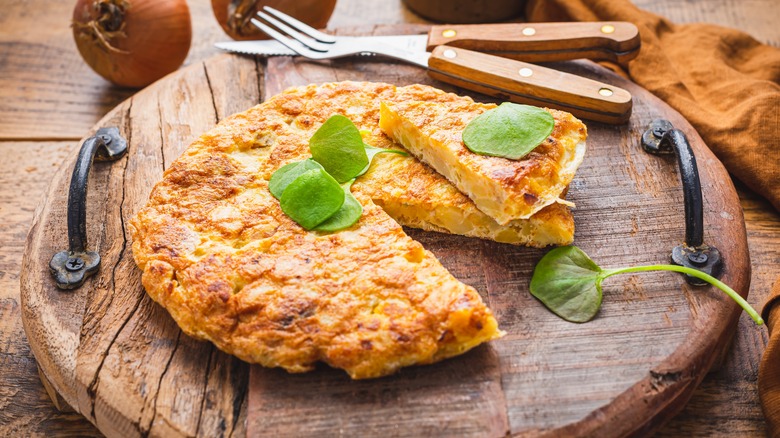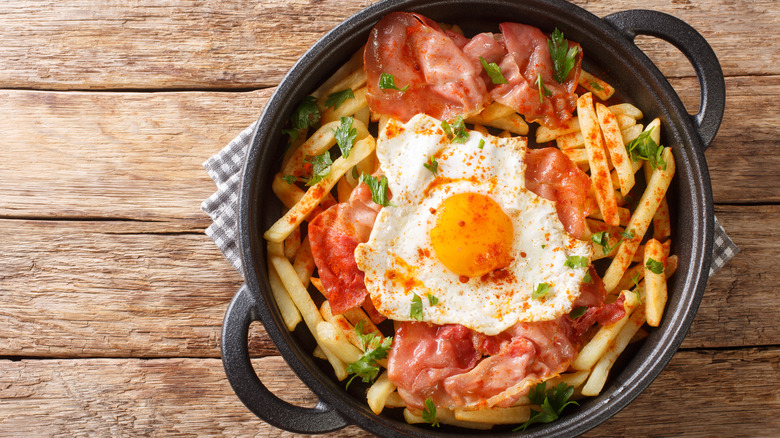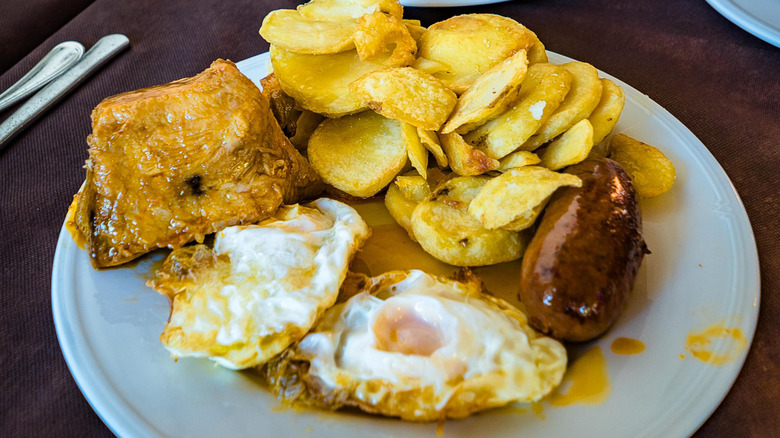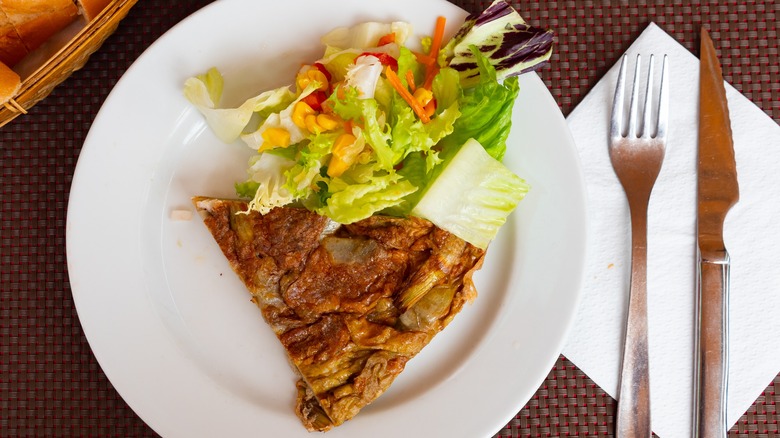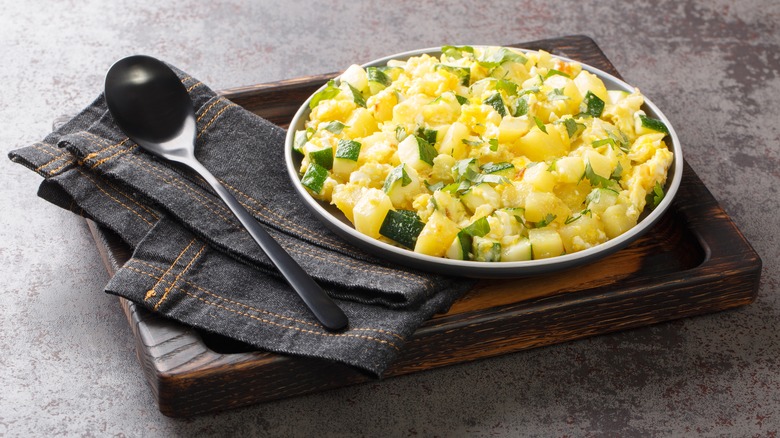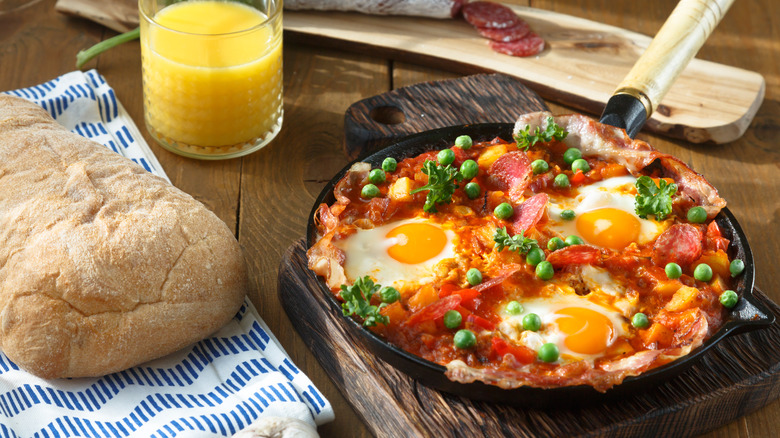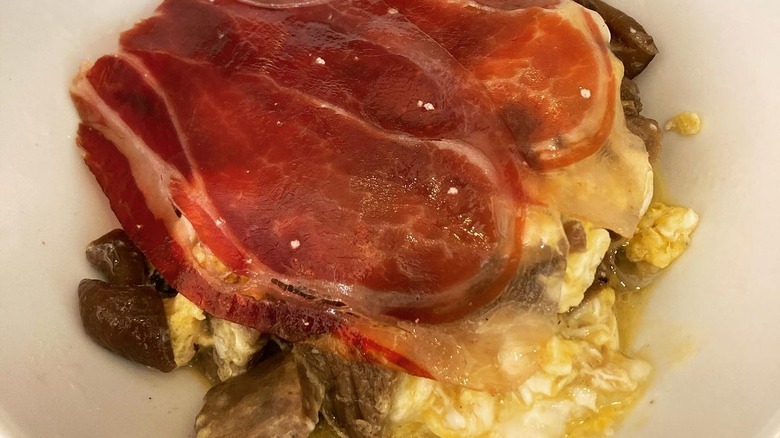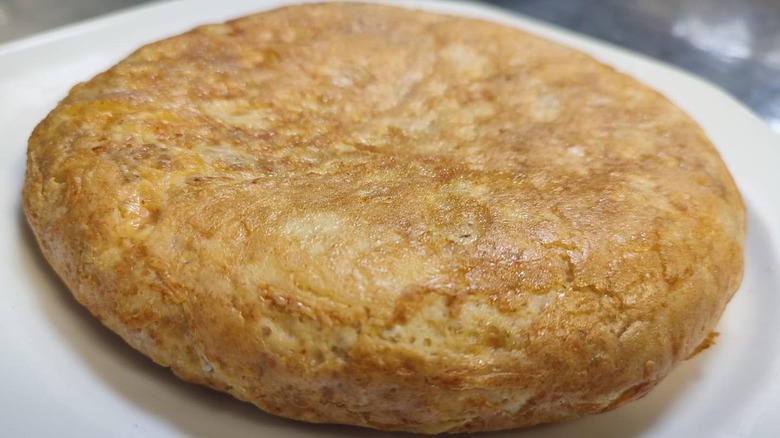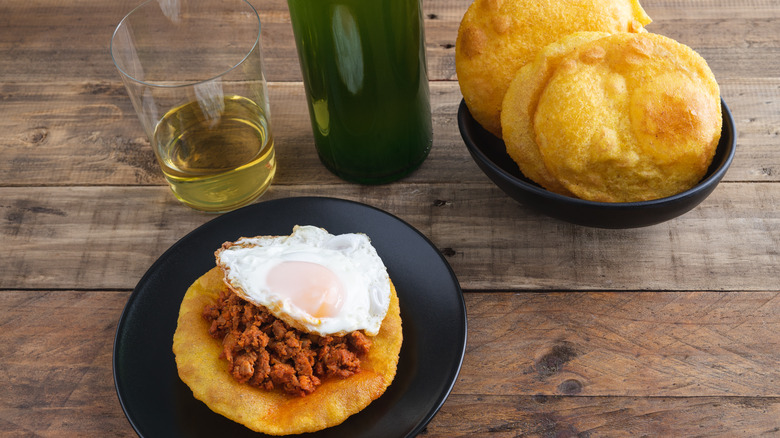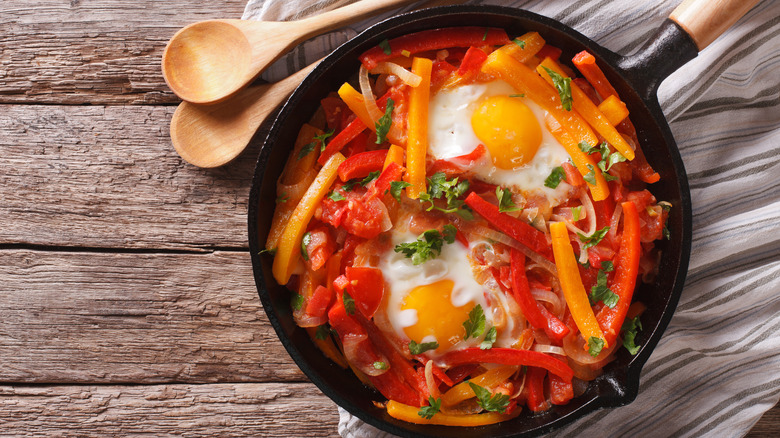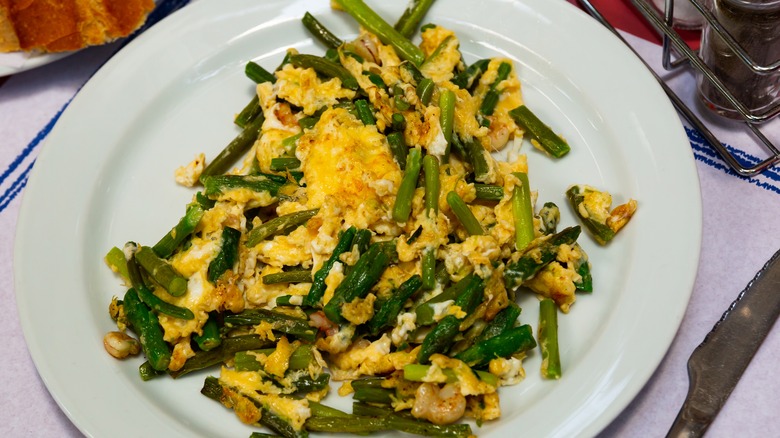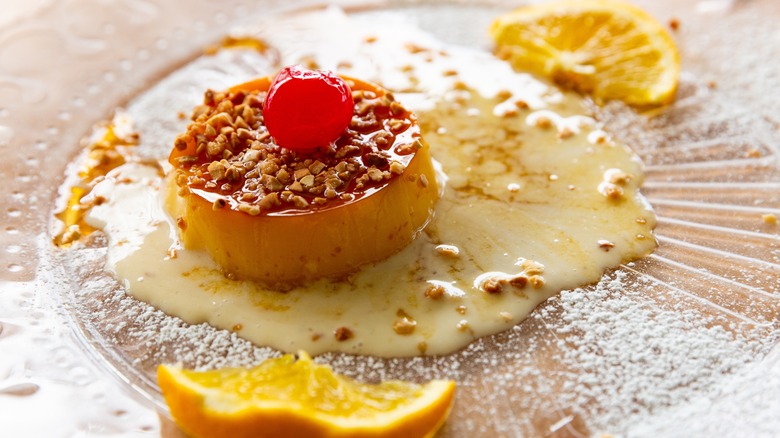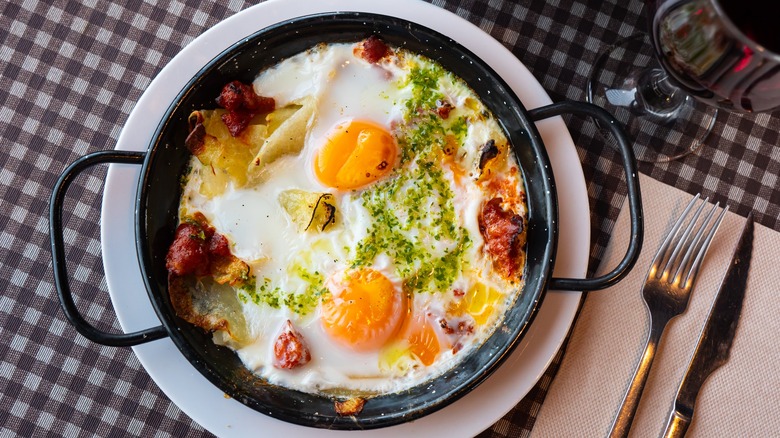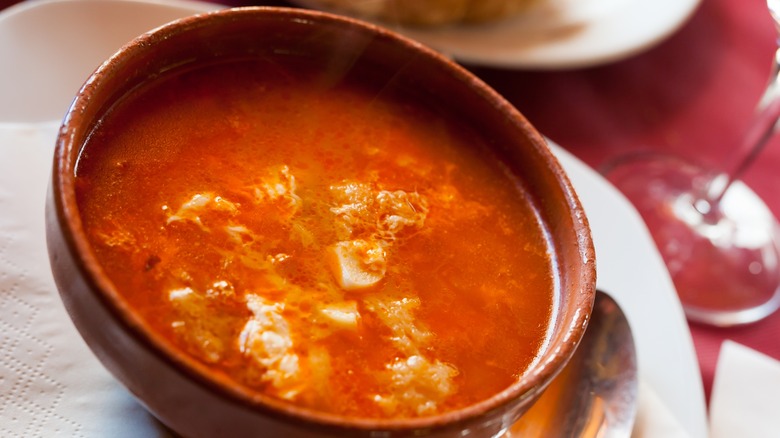15 Egg Dishes From Spain You Should Try At Least Once
Eggs are a beloved, nutritious food found in many cultures. They can be cooked in various ways, from soft-scrambled to sunny-side-up, over-easy, and omelet-style. This doesn't mean that people don't make rookie mistakes while preparing eggs, such as not keeping them at room temperature before frying them or not whisking them enough. Thankfully, these mishaps can be easily avoided, and it's no wonder this widely available ingredient is crucial in so many gastronomies.
Soufflé, quenelle, and quiche Lorraine, for instance, are some of the most delectable egg preparations found in French cuisine. How about we explore egg-centered dishes from neighboring Spain, where the annual domestic consumption has reached 961,215,463 pounds, according to Tridge. To help us navigate the particulars of 15 national and regional favorites, we reached out to Mat Schuster, the owner and executive chef of Canela Bistro and Wine Bar. The latter is a neighborhood Spanish restaurant located on San Francisco's Market Street and dedicated to revisiting traditional Spanish cuisine, using organic and gourmet ingredients. These are the tastiest huevo dishes that originated in Spain, and they deserve a spot on your gastronomic bucket list.
Tortilla Española (egg and potato omelet)
Not to be confused with the thin cornmeal or wheat flatbread that is commonly consumed in Mexico and Northern America, a tortilla in Spain consists of a round and thick omelet that has become a fixture of local cuisine. It has led to the creation of many dishes, such as the tortilla Española, also known as tortilla de patatas. Think of it as a hearty alternative to a brunch frittata that is filled with chopped yellow onions and thick sliced potatoes fried in olive oil. The Spanish serve it as either a side or a main dish.
Where did tortilla de patatas come from? It was apparently first popularized in Villanueva de la Serena in the 18th century, about 300 years after the conquistadores brought home potatoes from the colonies. To honor this creation, the village in question inaugurated a sculpture in 2021 in the heart of San Francisco Street.
According to Mat Schuster, this dish is a staple in Spanish homes and pairs well with beer, and he advises against baking it in the oven or hurrying the steps. The batter, "which should be the consistency of wet stew," needs to be poured over a hot nonstick pan over some olive oil. "Then," he adds, "reduce the heat of the pan and gently cook until there is enough of a wall of cooked egg to flip, and continue to cook on the other side." For inspiration, his own personal variation additionally includes green onion, bay shrimp, BBQ brisket, or morcilla (spiced blood sausage).
Huevos rotos (broken eggs with Serrano ham or chorizo)
Said to date back to the middle of the 19th century and originate from either Tenerife, the largest of the Canary Islands, or Madrid, huevos rotos are sometimes called huevos estrellados (crashed eggs) or huevos al estompido (smashed eggs). The dish consists of over-easy eggs typically made with Serrano or Iberian ham, chorizo, and/or morcilla, as well as thinly sliced potatoes fried in a lot of extra virgin olive oil. As for the vegetarian variation, it consists of cheese, caramelized onions, bell peppers, and mushrooms.
Though brunch isn't customary in Spain, Mat Schuster believes this dish definitely belongs in a brunch menu, and that it can be enjoyed with a Cava (Spanish sparkling wine) mimosa. He cautions against overcooking the eggs, though. Instead, you'll want to leave the egg intact, "so the crispy potatoes get a nice layer of runny yolk."
Plato de los montes de Málaga (platter from Málaga's mountains)
The aptly named combination platter from Málaga's mountains is a hearty, unassuming, classic dish that likely originated in the south of Spain. It was allegedly created by mountain mule drivers and skinners in the 1930s in order to keep them satiated on their physically demanding days. They prepared it from fried eggs, green bell peppers, and potatoes with blood sausage, chorizo, pork loin in red butter, and breadcrumbs. Today, plato de los montes is commonly served at family Sunday lunches, especially in winter and the fall.
According to Mat Schuster, this comforting and filling meal will keep people satisfied and energetic throughout the day. He adds that it would pair well with beverages that can cut through rich meat and the oil used for frying. Schuster's suggestions? A frothy beer, or a glass of sherry from the regional town, Jerez.
Tortilla de alcachofas (omelet with artichokes)
Fresh artichokes can be a little intimidating to work with, so people often turn to the canned or marinated varieties. The Spanish artichoke omelet, however, typically uses fresh peeled artichoke hearts and tender leaves that are pre-soaked in a mixture of lemon juice, water, and coarse salt. Mat Schuster favors a brand poached in olive oil that he imports from Spain. "They are really great!" he declares. "We flatten them out and sear them on the plancha or flat top, and they look like artichoke flowers. Put a nice sunny-side fried egg on top and a little crispy jamon Serrano, and enjoy!"
Schuster admits that artichokes may be difficult to pair drinks with, but he does propose serving a refreshingly sweet and citrusy beverage, such as agua de Valencia ("water from Valencia"). It's a Spanish cocktail from the east of Spain that is prepared with orange juice, gin, vodka, and a cava float.
Zarangollo Murciano (stewed zucchini and eggs from Murcia)
Zarangollo consists of very finely chopped or thinly sliced yellow onions and zucchinis, enhanced with crushed garlic cloves and fresh oregano. It is commonly served in the restaurants and tapas bars of Murcia, a southeastern Spanish region that is considered one of Europe's biggest producers of vegetables. Mat Schuster suggests pairing this dish with a light red wine, preferably a Spanish carbonic maceration. That's a specific fermentation method that likely hailed in France and produces fruit-forward wine with low tannin, a suitable accompaniment for simple, everyday meals.
Additionally, Schuster suggests not skimping on the olive oil and shredding another product made in the region on top of the dish: Murcia al Vino. The latter is a type of buttery, semi-hard, and wine-soaked goat cheese that is a favorite for snacking.
Yemas de Santa Teresa (Yolks of Saint Theresa)
Some of the most renowned Spanish desserts are egg-based, and that includes yemas de Santa Teresa, which translates to the "yolks of Saint Theresa." They're soft and spongy sweets that are prepared from egg yolks and granulated sugar, and then dusted with confectioners' sugar. The yemas were created to honor a beloved saint whose home region is Ávila, and that is why they're typically prepared there on her feast day, which falls on October 15. It's also a great way to repurpose any leftover yolks from another preparation.
Per Mat Schuster, one of the best drinks to complement this simple treat is a nutty Oloroso, a type of dry and aged sherry wine. As Sherry Notes puts it, "Oloroso means 'fragrant,' and the best examples will display dried fruits, leather, polished wood, and exotic spices."
Huevos a la flamenca (flamenco-style eggs)
Flamenco eggs, sometimes called gypsy eggs in other countries, is a colorful, nourishing dish that hails from Andalusia, the southernmost, predominantly agricultural region of Spain — and the birthplace of this eponymous folkloric music. Generally baked in a round terracotta pan, it consists of potatoes, peas, and smoky chorizo smothered in a tomato and roasted peppers sauce and topped with cracked eggs and Serrano ham. It's typically considered a first course and served with some crusty baguette or toast for dipping.
Mat Schuster compares flamenco eggs to a classic shakshuka, and proposes pairing it with a Spanish white wine, such as the acidic and fruity Albariño. He also cautions against leaving the pan in the oven too long, so as not to end up with overcooked yolks. "The hot stew underneath will continue to cook the eggs even out of the oven," he assures.
Revuelto de setas y jamón (scrambled eggs with mushroom and ham)
This popular dish combines scrambled eggs with any type of cured ham, such as jamón Ibérico, garlic-sautéed wild mushrooms (boletus or oyster, for instance), chopped garlic cloves, and sherry vinegar or white wine. The plate is then garnished with chopped parsley, served with crispy bread, and ideally paired with a Fino sherry — a dry white wine from palomino grapes — per Mat Schuster's recommendation.
Here's another tip from him to add some crunch to the mixture: "We like to bake thin slices of jamón Serrano ... until crispy and leave them to dry in the same oven after it is turned off overnight. The next day, we crumble the Serrano and use it as a topping on dishes such as these eggs."
A common mistake people make while preparing revuelto de setas y jamón is not sautéing the mushrooms until tender enough before combining in the eggs. "You want to cook the eggs until just done, which doesn't give much time for the mushrooms to cook," Schuster warns.
Tortilla del Sacromonte (Sacromonte omelet)
This Spanish tortilla is a filling and multi-textured casserole dish that hails from the Sacromonte abbey and neighborhood, in the southern city of Granada. It is typically served on February 1, on the feast of San Cecilio, the region's patron saint. The main ingredients bound by the eggs are sheep's brains and testicles, but other items are also commonly added, such as chorizo, peas, broad beans, ham, potatoes, onions, nuts, peppers, and breadcrumbs.
Evidently, the idea of consuming organ meats may be off-putting to some, but this type of food is considered a good source of folate, iron, protein, and vitamin B12. Thankfully, and probably to make it more appetizing, Mat Schuster suggests consuming that dish with a good shot of Spanish whiskey — not exactly a liquor normally associated with that country. DYC (Destilerías y Crianza), for instance, is one famous brand to consider.
Tortos Asturianos con picadillo y Cabrales (corn fritters with ground meat, eggs, and cheese) Asturias with ground meat and Cabrales)
Tortos Asturianos are corn fritters from the northwestern region of Asturias, typically prepared during Antroxu, a Catholic carnival that precedes Lent. They accompany either savory or sweet items, from jam to coffee, hot chocolate, cheese, and meat. One of the area's flagship dishes consists of those tasty fritters topped with fried eggs, Cabrales cheese, and minced pork or chorizo.
Cabrales is a regional, creamy, semi-hard, and crumbly blue cheese that's prepared from a mix of sheep, goat, and cow's milk. It goes without saying, then, that the dish pairs well with a liquor from Asturias — preferably cider, per Mat Schuster. He also suggests playfully replacing the Cabrales with another type of melted Asturian cheese. The latter come in more than 40 varieties, from La Peral to Gamonéu and Taramundi. "Asturias is a foodie's paradise," Schuster concludes.
Piperrada (pepper and egg stew)
Eggs piperade is a vibrant and rich dish from the northern Basque region that is typically prepared in a skillet from creamy eggs, various types and colors of bell peppers, sweet smoked paprika, tomatoes, onions, and extra virgin olive oil. Mat Schuster specifically advises against skimping on the oil. "It not only fries the peppers," he remarks, "but [it also] adds a tremendous amount of flavor."
Additionally, he suggests pairing the piperrada with a full-bodied Spanish red wine of the tempranillo kind. The latter is an ancient black grape variety that was apparently first grown in the Iberian Peninsula by the Phoenicians, who settled there around 800 BC. "Tempranillo" is the diminutive of "temprano," meaning early; it is a credit to those particular grapes that usually ripen long before others in the region.
Revuelto de ajetes con gambas (scrambled eggs with garlic and prawns)
Scrambled eggs don't have to be boring or plain in terms of flavor and texture. This creamy and fragrant dish, for instance, consists of scrambled eggs mixed with tender garlic shoots, prawns, extra virgin olive oil, and, occasionally, wild asparagus and ham shavings. There is also a variation with added parsley and/or chopped chistorra, which is a type of semi-cured chorizo mainly produced in the Basque, Navarra, or Aragon regions.
Mat Schuster insists on specifically using spring garlic in his recipe for a mild and fresh flavor, and he proposes elevating the dish with a bottle of a "slightly fizzy Basque Txakolina wine." The latter, often shortened to Txakoli (pronounced "cha-ko-lee"), is traditionally "poured into tall, flat-bottomed glasses from 8 to 10 inches in the air," according to Forbes, which is supposed to boost its "youthful effervescence."
Tocino de cielo (egg and syrup flan)
Tocino de cielo literally means "heaven's bacon," but there is absolutely no bacon involved in its confection. This is a very popular dessert that was allegedly popularized by the nuns of the Convent of the Holy Spirit in Jerez de la Frontera, in Andalusia. That is about as "heavenly" or holy as it gets. As for the main ingredients, they are very basic, widely available, and affordable: egg yolks, caster sugar, and lemon juice.
Mat Schuster also suggests enhancing the mixture by adding a hint of coffee. "Although not traditional," he remarks, "the flavors go well together." And as far as the beverage of choice is concerned, you can't go wrong with a café con leche at breakfast or a cortado at any other time of the day. Here's a word of caution from Schuster, though: "A dish like this is difficult to make, not only because you don't want to curdle the eggs, but also because a Spaniard is [inevitably] going to compare it to [the way] their grandma's [makes it]!" Understandable, as this is a must-try Spanish treat.
Huevos a la riojana (fried eggs La Rioja-style)
La Rioja is a region located in north-central Spain that produces a wide variety of vegetables, fruits, and grains. It is mainly renowned for recreational activities like hot-air ballooning and horseback riding, but also top-quality wines made from tempranillo and macabeo grapes. As for the popular La Rioja-style fried eggs, it's a typical regional dish that is prepared from green and red bell peppers, onions, chorizo, garlic, ripe tomatoes, sweet smoked Spanish paprika, and, of course, a copious amount of extra virgin olive oil.
According to Mat Schuster, a version with impossible meat could also be a suitable option for vegetarians. Personal variations don't matter all that much, but "the potatoes have to be soft, soft, soft!" he warns. "If you serve a Spaniard a crunchy potato, they will never forget it." Duly noted!
Sopa de ajo (egg and garlic soup)
Soup is a comforting and warming dish on chilly days. And if it's prepared with copious amounts of garlic, it will probably also provide several health benefits, such as reducing flu symptoms, blood pressure, and the risk of heart disease. Be as it may, this simple, yet flavorful egg and garlic soup was reportedly concocted by Castilian shepherds to keep them warm in the dead of winter. It's typically prepared with diced Serrano ham and smoked and sweet paprika and served with a baguette.
A glass of rosé from La Rioja wonderfully complements that rich, eggy, and smoky broth, as per Mat Schuster. Incorporating good quality pimentón (Spanish paprika) is primordial, though, and he fervently recommends the De La Vera brand. "Also, use a good chicken stock for the base," he adds. "Spanish recipes don't have a thousand ingredients; so, the ones that you use have to be of excellent quality."

